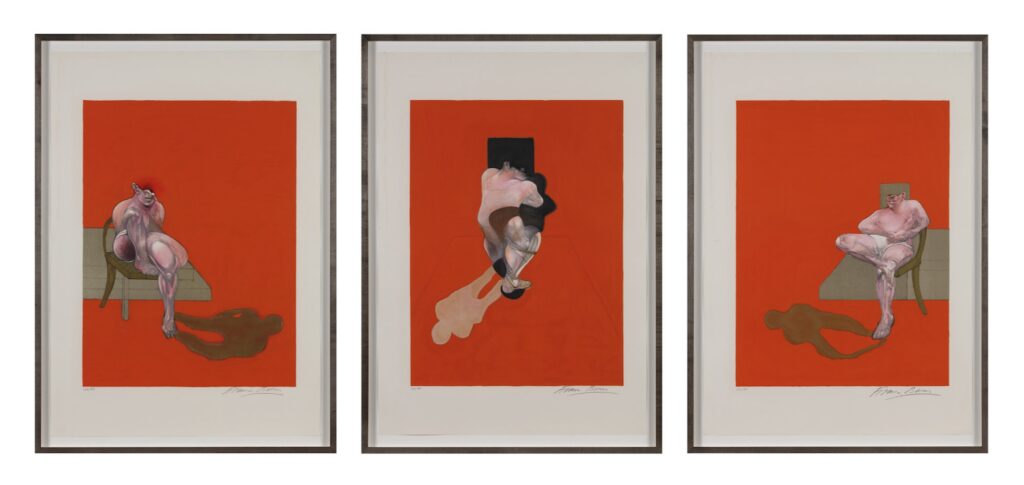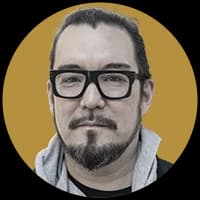Marlborough Gallery Sets Up a ‘Conversation’ Between Lucian Freud and Francis Bacon, Two Masters of the Artistic Persona
Bacon and Freud were the two bad boys of London painting from the 1940s onward. They were extravagant men with legendary appetites for booze, sex, and gambling.

“Conversations” devotes two floors of the Marlborough gallery to the work of Lucian Freud and Francis Bacon, placing work from the two 20th century giants next to each other. The gallery, which has long represented them both, has carefully selected prints and color lithographs from their archive-some never before seen.
The title suggests a dialogue, and the results are electrifying. The men were lifelong friends and rivals during London’s golden age of painting, and the resonances between them are fascinating, pitting Bacon’s brutal and blurred surrealism against Freud’s tortured but earthy mannerism. To see how each artist treats the figure, Freud with fleshy weight and Bacon with smeared violence, is eye opening.
It’s established that both artists had deep engagement with the history of painting and particularly classicism. Bacon famously copied Velasquez, and here we can see his continued engagement with the figure and the triptych format that dominated his “popes” series. Bacon’s tripled figures are more preening and less visceral here, as seen in a three color lithographs from 1983 and 1984.

Even so they still have the same dense, feral energy, as if each figure were a compression of the space around it. Their skin, a shade of cadaverous bruised pink, are offset by backgrounds of solid vermillion. The colors are lush, the figures are disturbing. Equally intriguing are the shadows, which snake away from them towards the viewer in ectoplasmic wisps. The stark contrasts heighten the theatrical drama. Bacon was nothing if not a stylist impossible to ignore.
Next to Freud’s monochrome, more studious heads and figures, one can immediately sense their difference in approach. Freud’s great love is the weight and texture of the body, the lavishness of physical presence. His visual impact is sculptural. He favored heavier, fleshier models, as evidenced in his long engagement with Leigh Bowery — fashion designer and queer London underground icon — and Bowery makes several appearances here as a model, as in the work “Large Head” from 1993.
Freud’s debt to Rembrandt’s anti-idealized and warmly imperfect engravings of women is definitely present, but it is tempered with a seriousness that brings Käthe Kollwitz to mind. These are faces caught in fleeting, possibly agonized moments, but presented in such a way as to make them almost monumental. Even so, his mannered distortions and use of engraving lines more closely resembling the brushstrokes of his painting also makes him an anti traditionalist and an innovator.

Bacon is restlessly, almost perversely, engaged in the abrupt fleetingness of the figure and face, temporally smeared as they often are across the canvas. He is forever situating and framing his models this way and that, staging rather than observing them. Bacon is invested in highly stylized and rapacious capture, while Freud seems to want to simply dive into his subjects.
Their different psychological approaches also become evident when viewed side by side. Bacon is concerned with an unpitying stare into the void of the human condition. Nothingness viciously haunts every piece, accompanied by a hungry search for carnal bits of something in all the nothing.
In “Three Studies,” he introduces mirrors in a theatrical fashion, as a philosophical study of self and narcissism. It is rooted in the everyday, but then puts it on a more abstracted plane. As such he has strong parallels to Beckett.
Freud, though the grandson of his famously atheistic grandfather, is far more of a humanist. As you can see in his portrait of Kai, there is a similar ennui and look into the void, but it is situated in the contemplative face of his sitter. There is a subtle but palpable beauty in the face, confounded as it is by life.
The etched lines swirl and come together to form an indelible presence, a personality, a something out of a fleeting nothing. Both artists may have the same flirtations with existentialism, but Freud’s subjects are insistently situated, in three dimensions, right before you. They are ripe with presence.
Bacon and Freud were the two bad boys of London painting from the 1940s onward. Both were extravagant men with legendary appetites for booze, sex, and gambling. Bacon was a longstanding fixture in London’s queer underground, while Freud sired 14 illegitimate children.
In addition to being figurative masters, they were also masters of the artistic persona. Bacon continuously riveted attention through his antics in posh restaurants and seedy gay bars. Freud was similarly famous for skulking through London’s streets while carrying a pet hawk on his wrist, raring for a fight.
Over four decades, their extremely close but tumultuous friendship had both men in each-other’s lives on a near daily basis. When not engaged in gambling and debauchery, they had a terse, often competitive sparring match in their respective painting studios. As London’s two most prominent figurative painters in an abstract era, they were also outsiders who needed each other. They most certainly improved each other’s work, electrifying the art world and becoming staggering successes in the process. Their paintings sold and continue to sell for millions.
At a certain point however, the friendship ended. They veered away from each other socially and stylistically. Looking from afar the divergence in their fundamental approach becomes obvious. Bacon has panache and arresting technique, but warmth in his work is lacking. It is very arresting, and very strong, but it is also cold, terribly cold.
Freud’s figures, fleshy, fallible, homely, have their own gravitas that draws you into them. They are vulnerable, real. Both men, quite similar in their temperaments and appetites, appear to have gone in different directions. After their breakup, they publicly panned each others later work.
Marlborough Gallery, which is soon to be shutting its doors after 80 years at the center of the modern and contemporary art world, has put together a thoughtful marvel of a show, capably curated and organized by director Bianca Barquet. Consisting entirely of work from their private catalog, it could have only been organized by an institution that has been so central to the art world for so many decades. It is a parting gift.

